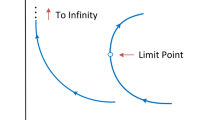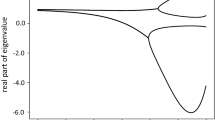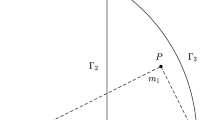Abstract
Our investigation is motivated by the recent discovery of asteroids orbiting the Sun and simultaneously staying near one of the Solar System planets for a long time. This regime of motion is usually called the quasi-satellite regime, since even at the times of the closest approaches the distance between the asteroid and the planet is significantly larger than the region of space (the Hill’s sphere) in which the planet can hold its satellites. We explore the properties of the quasi-satellite regimes in the context of the spatial restricted circular three-body problem “Sun–planet–asteroid”. Via double numerical averaging, we construct evolutionary equations which describe the long-term behaviour of the orbital elements of an asteroid. Special attention is paid to possible transitions between the motion in a quasi-satellite orbit and the one in another type of orbits available in the 1:1 resonance. A rough classification of the corresponding evolutionary paths is given for an asteroid’s motion with a sufficiently small eccentricity and inclination.

















Similar content being viewed by others
Notes
Being evidently unaware about the studies of QS-orbits by astrodynamicists, Namouni (1999), Namouni et al. (1999) used for this type of the orbital motion the term “retrograde satellite orbit” borrowed from the classical investigations of the periodic solutions in RC3BP. Looking through the literature it is easy to note that the celestial-mechanics community is not uniform in the choice of terms. Since our activity was stimulated by our long-standing discussions with the experts who coined the term “QS-orbit” in 80th (A. Yu. Kogan, M. L. Lidov and M. A. Vashkovyak), it predetermined our choice.
The provided definition of the resonance region is a standard for the studies of the resonant phenomena in multifrequency Hamiltonian system obtained from integrable one by a small perturbation of order \(\mu \) (Arnold et al. 2006). An asteroid entering the Hill sphere causes a violation of the condition (4), if the integrable Hamiltonian corresponds to the asteroid’s motion in a Keplerian orbit around Sun. For this reason, we will consider only such trajectories which are definitely distanced from the planet’s Hill sphere. The perturbation theory should be developed in a different way if one would like to take into account the dynamical effects emerging close or inside the Hill sphere (e.g. Robutel and Pousse 2013).
Some authors use for \(W(\varphi ,x,y,P_{h})\) the term “ponderomotive potential” following (Namouni et al. 1999).
If we consider a solution to the non-averaged system with the initial conditions \(x(0),y(0)\) exactly on \(\varGamma \), the dynamics will definitely be deterministic and depend mainly on to what part of fast subsystem separatrix the variables \(\varphi (0), \varPhi (0)\) belong. However, far from the uncertainty curve (i.e., deep inside the yellow zone in our phase portraits) the initial conditions corresponding to the crossing the above-mentioned parts of the separatrix in the plane \((\varphi , \varPhi )\) are mixed strongly. And a small uncertainty in the initial conditions does not allow us to predict uniquely the qualitative behavior of the system when the phase point leaves the vicinity of \(\varGamma \). Nevertheless, for the set of the possible initial conditions we can compare the measures of subsets resulting in the different qualitative behavior later on, and then characterize the dynamics in the probabilistic way.
References
Arnold, V.I., Kozlov, V.V., Neishtadt, A.I.: Mathematical Aspects of Classical and Celestial Mechanics, 3rd edn. Springer, New York (2006)
Batygin, R., Morbidelli, A.: Analytical treatment of planetary resonances. Astron. Astrophys. 556, A28 (2013)
Benest, D.: Libration effects for retrograde satellites in the restricted three-body problem. I: Circular plane Hill’s case. Celest. Mech. 13, 203–215 (1976)
Benest, D.: Effects of the mass ratio on the existence of retrograde satellites in the circular restricted problem. IV. Three-dimensional stability of plane periodic orbits. Astron. Astrophys. 54, 563–568 (1977)
Brasser, R., Innanen, K.A., Connors, M., Veillet, C., Wiegert, P., Mikkola, S., Chodas, P.W.: Transient coorbital asteroids. Icarus 171, 102–109 (2004)
Broucke, R.A.: Periodic orbits in the restricted three-body problem with Earth–Moon masses. NASA Technical Report, pp. 32–1168 (1968)
Cary, J.R., Escande, D.F., Tennyson, J.L.: Adiabatic invariant change due to separatrix crossing. Phys. Rev. A 34, 4256–4275 (1986)
Christou, A.A.: A numerical survey of transient co-orbitals of the terrestial planets. Icarus 144, 1–20 (2000)
Connors, M., Veillet, C., Brasser, R., Wiegert, P., Chodas, P., Mikkola, S., Innanen, K.: Discovery of Earth’s quasi-satellite. Meteorit. Planet. Sci. 39, 1251–1255 (2004)
de la Fuente Marcos, C., de la Fuente Marcos, R.: (309239) 2007RW10: a large temporary quasi-satellite of Neptune. Astron. Astrophys. 545, L9 (2012)
Garfinkel, B.: Theory of the Trojan asteroids. I. Astron. J. 82, 368–379 (1977)
Gil, P.J.S., Schwartz, J.: Simulations of quasi-satellite orbits around phobos. J. Guid. Control Dyn. 33, 901–914 (2010)
Gladman, B.: Dynamics of systems of two close planets. Icarus 106, 247–263 (1993)
Gradshteyn, I.S., Ryzhik, I.M.: Table of Integrals, Series, and Products, 7th edn. Academic Press, New York (2007)
Guippone, C.A., Beaugé, C., Michtchenko, T.A., Ferraz-Mello, S.: Dynamics of two planets in co-orbital motion. Mon. Not. R. Astron. Soc. 407, 390–398 (2010)
Henon, M.: Numerical exploration of the restricted problem. V. Hill’s case: periodic orbits and their stability. Astron. Astrophys. 1, 223–238 (1969)
Henon, M.: Generating Families in the Restricted Three Body Problem. Springer, Berlin (1997)
Henrard, J.: The adiabatic invariant: the use in celestial mechanics. In: NATO ASI Proc. 82: Applications of Modern Dynamics to Celestial Mechanics and Astrodynamics, pp. 153–171 (1982)
Jackson, J.: Retrograde satellite orbits. Mon. Not. R. Astron. Soc. 74, 62–82 (1913)
Kinoshita, H., Nakai, H.: Quasi-satellites of Jupiter. Celest. Mech. Dyn. Astron. 98, 181–189 (2007)
Kogan, AYu.: Distant satellite orbits in the restricted circular three-body problem. Cosm. Res. 24, 705–710 (1989)
Kogan, A.Yu.: Quasi-satellite orbits and their applications. In: Proceedings of the 41st Congress of the International Astronautical Federation, edited by R. Jehn. Paper, pp. 90–307 (1990)
Kortenkamp, S.J.: An efficient, low-velocity, resonant mechanism for capture of satellites by a protoplanet. Icarus 175, 409–418 (2005)
Lidov, M.L., Vashkovyak, M.A.: Perturbation theory and analysis of the evolution of quasi-satellite orbits in the restricted three-body problem. Cosm. Res. 31, 187–207 (1993)
Lidov, M.L., Vashkovyak, M.A.: On quasi-satellite orbits in the restricted elliptic three-body problem. Astron. Lett. 20, 676–690 (1994)
Lidov, M.L., Ziglin, S.L.: The analysis of restricted circular twice-averaged three body problem in the case of close orbits. Celest. Mech. 9, 151–173 (1974)
Mikkola, S., Innanen, K.: Orbital stability of planetary quasi-satellites. In: Dvorak, R., Henrard, J. (eds.) The Dynamical Behavior of Our Planetary System, pp. 345–355. Kluwer, Boston (1997)
Mikkola, S., Brasser, R., Wiegert, P., Innanen, K.: Asteroid 2002VE68, a quasi-satellite of Venus. Mon. Not. R. Astron. Soc. 351, L63–65 (2004)
Mikkola, S., Innanen, K., Wiegert, P., Connors, M., Brasser, R.: Stability limits for the quasi-satellite orbit. Mon. Not. R. Astron. Soc. 369, 15–24 (2006)
Murray, C.D., Dermott, S.F.: Solar System Dynamics. Cambridge University Press, Cambridge (1999)
Namouni, F.: Secular interactions of coorbiting objects. Icarus 137, 293–314 (1999)
Namouni, F., Christou, A.A., Murray, C.D.: Coorbital dynamics at large eccentricity and inclination. Phys. Rev. Lett. 83, 2506–2509 (1999)
Neishtadt, A.I.: Change of an adiabatic invariant at a separatrix. Sov. J. Plasma Phys. 12, 568–573 (1986)
Neishtadt, A.I.: Jumps of the adiabatic invariant on crossing the separatrix and the origin of the 3:1 Kirkwood gap. Sov. Phys. Dokl. 32, 571–573 (1987)
Neishtadt, A.I.: On the change in the adiabatic invariant on crossing a separatrix in systems with two degrees of freedom. J. Appl. Math. Mech.-USSR 51, 586–592 (1987)
Neishtadt, A.I., Sidorenko, V.V.: Wisdom system: dynamics in the adiabatic approximation. Celest. Mech. Dyn. Astron. 90, 307–330 (2004)
Nesvorny, D., Thomas, F., Ferraz-Mello, S., Morbidelli, A.: A perturbative treatment of the co-orbital motion. Celest. Mech. Dyn. Astron. 82, 323–361 (2002)
Robutel, P., Pousse, A.: On the co-orbital motion of two planets in quasi-circular orbits. Celest. Mech. Dyn. Astron. 117, 17–40 (2013)
Sagdeev, R.Z., Zakharov, A.V.: Brief history of the Phobos mission. Nature 341, 581–585 (1989)
Sidlichovsky, M.: A non-planar circular model for the 4/7 resonance. Celest. Mech. Dyn. Astron. 93, 167–185 (2005)
Sidorenko, V.V.: Evolution of asteroid orbits at resonance 3: 1 of their mean motions with Jupiter (planar problem). Cosm. Res. 44, 440–455 (2006)
Schubart, J.: Long-period effects in nearly commensurable cases of the restricted three body problem. Smithson. Astrophys. Obs. Spec. Report 149 (1964)
Timofeev, A.V.: On the problem of constancy of the adiabatic invariant during change of the type of motion. Sov. Phys. JETP 75, 1303–1308 (1978)
Tuchin, A.G.: Quasi-synchronous orbits and their employment for the approach of a spacecraft to Phobos. Cosm. Res. 45, 131–136 (2007)
Vashkovyak, M.A.: Numerical averaging method in the problem of the evolution of resonance asteroid orbits. Cosm. Res. 27, 6–11 (1989)
Wajer, P.: 2002AA29: Earth’s recurrent quasi-satellite? Icarus 200, 147–153 (2009)
Wajer, P.: Dynamical evolution of Earth’s quasi-satellites: 2004GU9 and 2006FV35. Icarus 209, 488–493 (2010)
Wiegert, P.A., Innanen, K.A., Mikkola, S.: The orbital evolution of near-Earth asteroid 3753. Astron. J. 115, 2604–2613 (1998)
Wisdom, J.: A perturbative treatment of motion near the 3/1 commensurability. Icarus 63, 272–286 (1985)
Yokoyama, T.: A simple generalization of Wisdom’s perturbative method. Celest. Mech. Dyn. Astron. 64, 243–260 (1996)
Acknowledgments
The work was supported in part by the Russian Foundation for Basic Research (projects 13-01-00251 and NSh-2519.2012.1) and by the Presidium of the Russian Academy of Sciences under the scope of the Program 22 “Fundamental problems of Solar System investigations”. We are grateful to M.A.Vashkovyak and M.Efroimsky for reading the manuscript and useful discussions. We thank also anonymous referees for all their corrections and suggestions.
Author information
Authors and Affiliations
Corresponding author
Additional information
Results of this paper were partially presented as Paper DDA 101.04 at the 44th Annual Meeting of the Division on Dynamical Astronomy of the American Astronomical Society, 2013, Paraty, Brazil.
Appendices
Appendix A: Calculation of the function \(W\) and its derivatives
Below we describe some technical details of the computational procedure which has been applied to obtain numerically the values of the averaged disturbing function
and of its derivatives
with no limitations on the asteroid’s eccentricity or inclination.
A1.Change of the variable, over which the integration takes place. To start with, we replace in (31) the integration over the auxiliary variable \(\overline{h}\) with integration over the asteroid’s eccentric anomaly \(E\). This allows us to avoid the necessity to solve the Kepler equation in our calculation of the asteroid’s position. The relation between the variables \(\overline{h}\) and \(E\) reads as
As a result, the expressions for \(W\) and its derivative can be written as
where
The “minus” sign before the integrals in formulae (33) appears due to our intention to have the upper limit larger than the lower one.
A2. Derivatives of \(R\) with respect to \(\varphi ,x,y,P_{h}\). At this point, we need to introduce the uniformly rotating heliocentric reference frame \(O\xi \eta \zeta \) with the axis \(O\xi \) being directed from the Sun to the planet and the axis \(O\zeta \) being aligned with the normal to the plane of the primary’s orbital motion. In this reference frame the position vector of the planet is \(\mathbf{{r}}'=\mathbf{{e}}_\xi \), where \(\mathbf{{e}}_\xi =(1,0,0)^T\) is the unit vector corresponding to axis \(O\xi \). Respectively the expression for disturbing function (2) is reduced to
Then we get:
where
A3. Position vector of the asteroid. Let the unit vector \(\mathbf{{e}}^*_\xi \) be directed to the pericenter of the osculating orbit, while one more unit vector \(\mathbf{{e}}^*_\eta \) is parallel to this orbit’s minor semi-axis (and directed in the same way as asteroid’s velocity vector at the pericenter). It is not difficult to write down the expressions for introduced unit vectors through their projections on the axes of the reference frame \(O\xi \eta \zeta \):
and
After that the asteroid’s position vector \(\mathbf{{r}}\) can be written as the linear combination
with the coefficients (here the orbit with \(a=1\) is considered)
A4. Derivatives of the position vector \(\mathbf{{r}}\) with respect to \(\varphi ,x,y,P_{h}\). Taking into account (32) and (36) we obtain the following relations:
where evidently
A5. Derivatives of the position vector \(\mathbf{{r}}\) with respect to \(\overline{h}\) and osculating variables \(i,e,\omega \). Direct differentiation of (36) results in
where
The derivatives of the unit vectors \(\mathbf{{e}}^*_\xi \) and \(\mathbf{{e}}^*_\eta \) in (37) can be easily evaluated from (34) and (35) respectively.
A6. Derivatives of the osculating variables \(e,i,\omega \) with respect to \(x,y,P_{h}\). First we rewrite the expressions for \(e,\cos i,\sin i\) in a more compact way [compare with (6)]:
Here
After the differentiation of the expressions (38) with respect to \(x,y\) we obtain:
and
To finalise we need to find \(\partial \omega /\partial x\) and \(\partial \omega /\partial y\). Taking into account in what way the variables \(x,y\) were introduced [i.e., formulae (5)], the obvious relations can be written:
Differentiating (39) we get:
Appendix B: Calculation of the leading term \(\overline{W}\) of the averaged disturbing function
As it was mentioned in Sect. 4, the leading term \(\overline{W}\) in the expression for disturbing function (19) and its derivatives
can be written in terms of complete elliptic integrals \(K(k)\) and \(E(k)\) of the first and second kind.
B1. Calculation of \(\overline{W}\). We begin with a slightly modified version of the formula used above to define \(\overline{W}\):
where \(u=-\overline{h}=\lambda '-h\),
By means of the standard change of variables \(\xi = \mathop {\mathrm{tg}}\nolimits \frac{u}{2}\), we obtain:
Here \(P_4(\xi )\) denotes the forth degree polynomial
with the coefficients rendered by the formulae
The integral (40) has a finite value only in the case \(\varDelta (u,\overline{\varphi },\overline{x},\overline{y})\ne 0\) for \(\forall u\in [-\pi ,\pi ]\). It takes place when all the roots \(\xi _1,\ldots ,\xi _4\) of the equation \(P_4(\xi )=0\) are not real:
If \(a_{1,2}\) and \(b_{1,2}\) are known, the value of \(\overline{W}\) is provided by the formula
where
B2. Calculation of the derivatives of \(\overline{W}\). By differentiation of (41) we arrive at the evident formulae
where
Then we apply the change of the variable in (42) as
The auxiliary quantity \(\sigma _*\) in (43) is defined by the relations
The change of variable (43) allows us to express \(X_0,\ldots ,X_4\) as linear combinations of the integrals
with
With the aid of the standard handbook Gradshteyn and Ryzhik (2007), one can easily find that
So the relations connecting the integrals \(I_k\) and \(X_k\) allow to express \(X_k\) in terms of complete elliptic integrals too. Omitting the cumbersome calculations we write down these relations in the recursive form
B3. Computation of the second derivative with respect to \(\overline{\varphi }\). To make a conclusion regarding the possibility of a QS-regime at given values of \(\overline{x},\overline{y}\), we need to know the sign of \(\partial ^2 \overline{W}/\partial \overline{\varphi }^2\) at \(\overline{\varphi }=0\) (Christou 2000). The answer can be obtained through the use of the formula
where
We can add also that the value of \(\overline{W}\) at \(\overline{\varphi }=0\) is provided by the formula
Up to notation, the formula (44) coincides with the formula (46) for the secular potential in Namouni (1999), which was used there to study the limiting case of QS-orbits with non-oscillating resonant phase \(\varphi \).
Rights and permissions
About this article
Cite this article
Sidorenko, V.V., Neishtadt, A.I., Artemyev, A.V. et al. Quasi-satellite orbits in the general context of dynamics in the 1:1 mean motion resonance: perturbative treatment. Celest Mech Dyn Astr 120, 131–162 (2014). https://doi.org/10.1007/s10569-014-9565-4
Received:
Revised:
Accepted:
Published:
Issue Date:
DOI: https://doi.org/10.1007/s10569-014-9565-4




